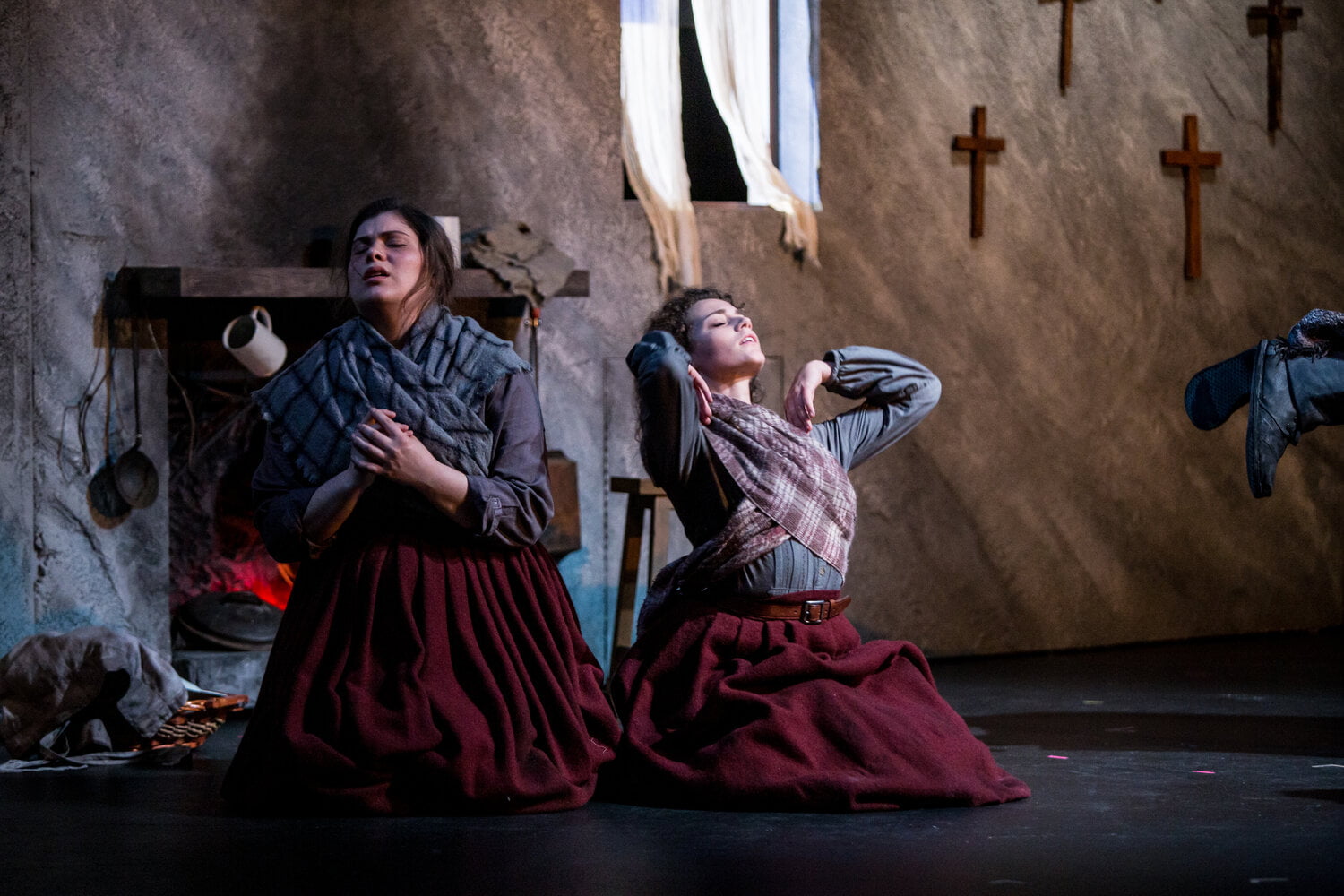Riders to the Sea by Irish playwright, poet, writer, and literary icon J.M. Synge is a play set in the Aran Islands, that concerns itself with the anxieties, grief, and eventual rational acceptance of the subsequent deaths of all the men in Maurya, the protagonist’s family. She is a grief-stricken woman who loses her husband and five sons to the sea.
While also weaving a narrative of the Irish nationalist identity through Maurya and the struggles of the Irish peasants against the colonial powers, Synge symbolises the struggle and destiny of Mother Ireland through the figure of Maurya in the play. The miseries of Maurya are symbolic of the agonies of Ireland as she loses young sons fighting against a force that she cannot defeat.

The plot of Riders to the Sea takes place in a little cottage. The men in the play are shown to be “riding” out of necessity, to make a living for themselves, because they have no alternative. The women on the other hand, have to bear the loss of their loved ones as they stay in isolation.
The isolation of Maurya’s daughters Nora and Cathleen can be said to reflect the isolation that the inhabitants of such far-off islands were living in. Synge’s craft does not make use of provocative language, but still manages to pierce into the heart of the reader through the depictions of the material conditions of Maurya’s household where the kitchen barely has enough food, and the men regularly risk their lives to earn a livelihood in the endless tradition of going to the sea.
Similar to many other Irish writers, Synge uses Maurya as the metaphorical maternal landscape of feminine Ireland who loses her sons for the greater goal, i.e., freedom. In doing so, he asserts an authentic Irish identity of resistance and endurance within the colonial apparatus and represents the miseries that plague ‘her‘ under the brutal English imperialistic enterprise
Although several critics like Philip Beitchman, Keith N. Hull, and Joy Kennedy have emphasised the overwhelming elements of naturalism in Riders to the Sea, the political symbolism mirrored through various motifs and the struggles of its tragic protagonist Maurya has often gone unnoticed (Kang 3).
Synge’s nuanced way of representing Ireland’s colonial conditions do not fit within the conventional framework of militaristic nationalism or ideal nationalism. In Riders to the Sea,he paints the sea as the merciless antagonist and inevitably draws a parallel with the seemingly invincible English, both of which are the reasons for the demise of countless young Irish lives.
Also read: Are Marriages Made In Heaven?: An Analysis Of Henrik Ibsen’s Iconic Play ‘A Doll’s House’

As Riders to the Sea progresses, and the agony and anxieties of Maurya, the literal maternal figure come to a culmination, it is hard to ignore the intersection of the personal and the political as one cannot possibly understand Synge’s play without delving into the postcolonial context in which he wrote it.
Similar to many other Irish writers, Synge uses Maurya as the metaphorical maternal landscape of feminine Ireland who loses her sons for the greater goal, i.e., freedom. In doing so, he asserts an authentic Irish identity of resistance and endurance within the colonial apparatus and represents the miseries that plague ‘her‘ under the brutal English imperialistic enterprise.
Riders to the Sea is understandably anti-imperialistic, however, through the agonising portrayals of Maurya’s suffering, Synge also questions the traditional ideals of sacrifices associated with motherhood and independence movements built on the backs of countless unknown women.
Synge subverts the gendered narrative of the old ‘weak‘ woman and hails Maurya’s stoic acceptance of grief, resilience, rationale, and endurance as a representation of Ireland’s fight against English colonialism, thus, successfully upholding the narrative of Irish distinctiveness from the English
When Maurya learns of the news of Bartley, her sixth son’s death, she grieves but soon consoles herself, seeking resignation in the thought that “they’re [all the dead men in her family] all together this time”. She seeks comfort in the idea that no man is immortal and that both Michael and Bartley will get a clean burial, thus reconciling with their deaths and gaining a kind of independence from all her anxieties.

Maurya “finds [her] voice and gesture to revolt against oppressive circumstances” (Murray 64). Bartley’s death frees her in a way from the constant worry about his life, and therefore, the grief has not just merely brought resignation, but also emboldened her with the assertion of independence.
The following lines reflect Maurya’s newly found rationalised independence from the sea, and one can also locate her sacrifices for the greater goal of Ireland’s freedom against the colonial tyranny, marking her “postcolonial existence” (Kang 8):
Maurya: Raising her head and speaking as if she did not see the people around her.—They’re all gone now, and there isn’t anything more the sea can do to me…. I’ll have no call now to be up crying and praying when the wind breaks from the south, and you can hear the surf is in the east, and the surf is in the west, making a great stir with the two noises, and they hitting one on the other. I’ll have no call now to be going down and getting Holy Water in the dark nights after Samhain, and I won’t care what way the sea is when the other women will be keening.
Also read: The Celebration Of Sisterly Love In Louisa May Alcott’s ‘Little Women’
In his journal The Aran Islands, Synge makes the political importance of the Irish peasantry abundantly clear. Although one of his contemporaries and friend, the Irish writer W.B Yeats considered Synge to be unfit “to think a political thought”, the way Synge borrows from the Celtic culture instead of English, makes Maurya’s character gain “momentum to form a counter-narrative to [the] Anglocentric imperialist discourse“.
In doing so, Synge subverts the gendered narrative of the old ‘weak‘ woman and hails Maurya’s stoic acceptance of grief, resilience, rationale, and endurance as a representation of Ireland’s fight against English colonialism, thus, successfully upholding the narrative of Irish distinctiveness from the English.
References:
Synge, J.M. “Riders to the Sea by J. M. Synge.” Project Gutenberg, 1 July 1997
Skelton, Robin. “The Politics of J. M. Synge”
Kang, Meeyoung. “The Political Aesthetics of John M. Synge’s Riders to the Sea.” 2 Sept. 2020,
Murray, Christopher. Twentieth Century Irish Drama. Manchester: Manchester UP., 1997. Print
The featured image is from an enactment of Riders to the Sea directed by Mary Birnbaum
Image Source: Amanda Seymour Costume
About the author(s)
Poulomi is a Master's scholar from Jamia Millia Islamia, New Delhi, who loves to scribble poetry and write essays just when she can't seem to hold it all in. Her research interests include feminist studies, postcolonial theory, trauma and disability studies. She is very eager to read anything she can get her hands on, when she is not obsessing over spicy food or sleeping





